Action camera company GoPro (NASDAQ:GPRO) beat analysts' expectations in Q1 CY2024, with revenue down 11% year on year to $155.5 million. It made a non-GAAP loss of $0.21 per share, down from its loss of $0.19 per share in the same quarter last year.
GoPro (GPRO) Q1 CY2024 Highlights:
- Revenue: $155.5 million vs analyst estimates of $146.5 million (6.1% beat)
- Adjusted EBITDA: ($29.3) million loss vs analyst estimates of ($38.9) million loss (large beat)
- EPS (non-GAAP): -$0.21 vs analyst estimates of -$0.25 ($0.04 beat)
- Gross Margin (GAAP): 34.1%, up from 30% in the same quarter last year
- Free Cash Flow was -$99.37 million, down from $43.19 million in the previous quarter
- Market Capitalization: $290.9 million
Known for sponsoring extreme athletes, GoPro (NASDAQ:GPRO) is a camera company known for its POV videos and editing software.
GoPro has revolutionized how people capture and share their most adventurous moments through its flagship Hero cameras. This core product is designed to withstand extreme conditions and environments, making it popular among outdoor enthusiasts, extreme sports athletes, and travelers. GoPro cameras have a robust build, waterproof capabilities, and wide-angle lenses, allowing users to capture immersive POV footage.
To complement its cameras, GoPro offers a range of accessories, such as mounts, stabilizers, and cases. Beyond hardware, the company offers the GoPro Quik app, allowing users to manage, edit, and share content with their mobile devices through a Wi-Fi and Bluetooth connection. In the app, users can access premium editing and cloud storage features by paying a monthly subscription.
GoPro's marketing strategy has been pivotal to its reputation. The company often features thrilling content filmed on its devices to showcase the capabilities of its products. This approach has not only driven product sales but also built an engaged community of GoPro users.
Toys and Electronics
The toys and electronics industry presents both opportunities and challenges for investors. Established companies often enjoy strong brand recognition and customer loyalty while smaller players can carve out a niche if they develop a viral, hit new product. The downside, however, is that success can be short-lived because the industry is very competitive: the barriers to entry for developing a new toy are low, which can lead to pricing pressures and reduced profit margins, and the rapid pace of technological advancements necessitates continuous product updates, increasing research and development costs, and shortening product life cycles for electronics companies. Furthermore, these players must navigate various regulatory requirements, especially regarding product safety, which can pose operational challenges and potential legal risks.
GoPro's primary competitors include Sony (NYSE:SONY), Garmin (NASDAQ:GRMN), Canon (NYSE:CAJ), Nikon (OTC:NINOY), and private company DJI Technology.Sales Growth
Reviewing a company's long-term performance can reveal insights into its business quality. Any business can have short-term success, but a top-tier one sustains growth for years. GoPro's revenue declined over the last five years, dropping 3.7% annually. 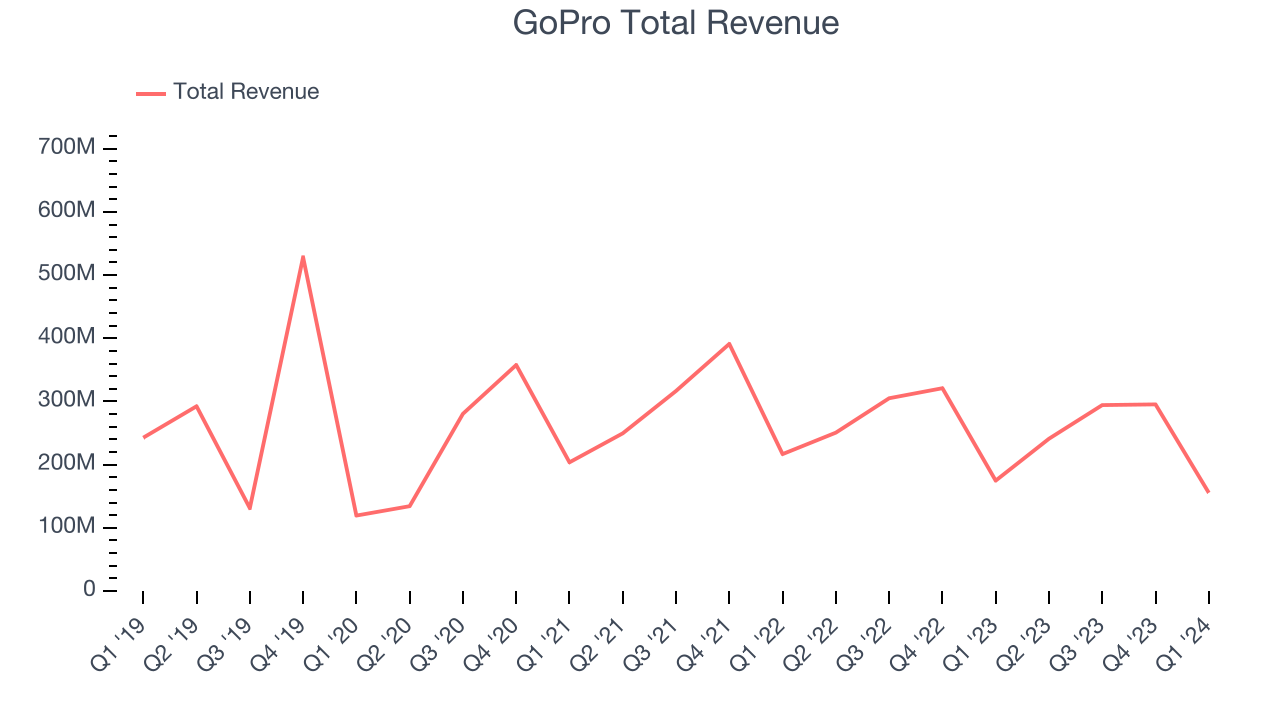 Within consumer discretionary, product cycles are short and revenue can be hit-driven due to rapidly changing trends. That's why we also follow short-term performance. GoPro's recent history shows its demand has decreased even further as its revenue has shown annualized declines of 8.4% over the last two years.
Within consumer discretionary, product cycles are short and revenue can be hit-driven due to rapidly changing trends. That's why we also follow short-term performance. GoPro's recent history shows its demand has decreased even further as its revenue has shown annualized declines of 8.4% over the last two years.
This quarter, GoPro's revenue fell 11% year on year to $155.5 million but beat Wall Street's estimates by 6.1%. Looking ahead, Wall Street expects sales to grow 5.2% over the next 12 months, an acceleration from this quarter.
Operating Margin
Operating margin is a key measure of profitability. Think of it as net income–the bottom line–excluding the impact of taxes and interest on debt, which are less connected to business fundamentals.
Given the consumer discretionary industry's volatile demand characteristics, unprofitable companies should be scrutinized. Over the last two years, GoPro's high expenses have contributed to an average operating margin of negative 4.2%.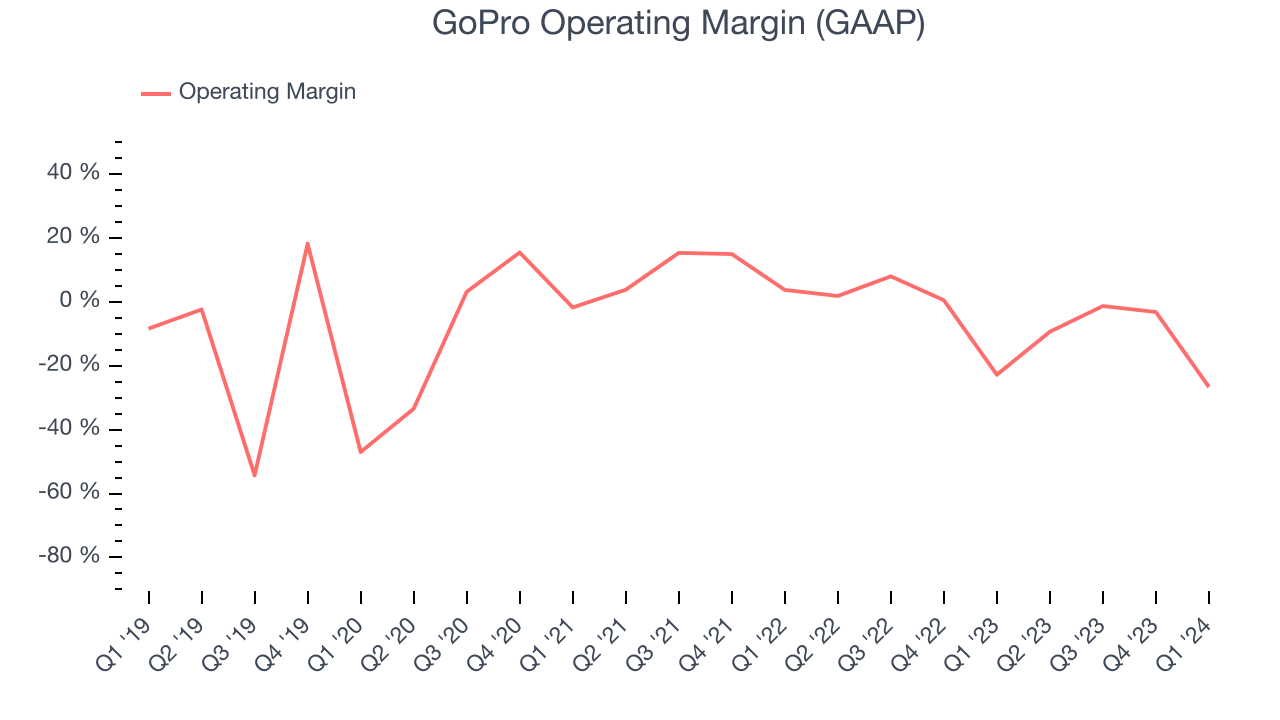
In Q1, GoPro generated an operating profit margin of negative 26.6%, down 3.9 percentage points year on year.
Over the next 12 months, Wall Street expects GoPro to shrink its losses but remain unprofitable. Analysts are expecting the company’s LTM operating margin of negative 7.8% to rise to negative 2%.EPS
We track long-term historical earnings per share (EPS) growth for the same reason as long-term revenue growth. Compared to revenue, however, EPS highlights whether a company's growth was profitable. 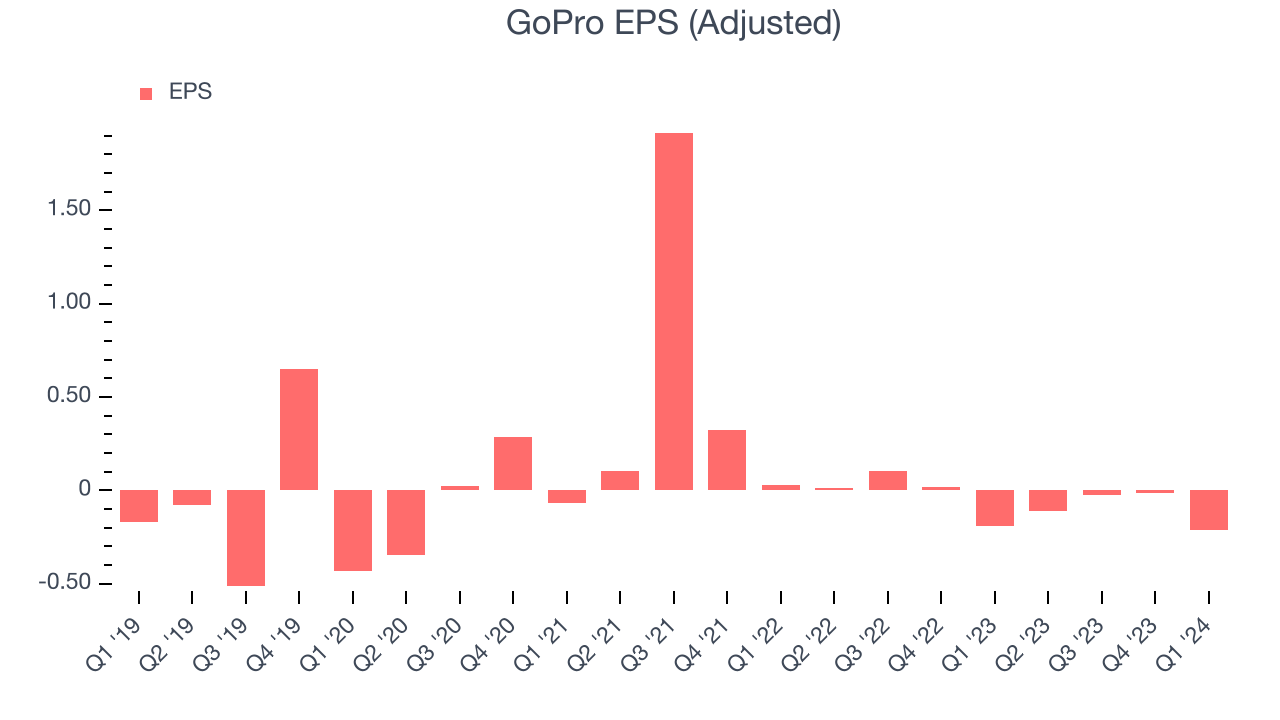
Over the last five years, GoPro cut its earnings losses and improved its EPS by 2.5% each year.
In Q1, GoPro reported EPS at negative $0.21, down from negative $0.19 in the same quarter last year. Despite falling year on year, this print beat analysts' estimates by 14.9%. Over the next 12 months, Wall Street is optimistic. Analysts are projecting GoPro's LTM EPS of negative $0.36 to reach break even.
Cash Is King
Although earnings are undoubtedly valuable for assessing company performance, we believe cash is king because you can't use accounting profits to pay the bills.
Over the last two years, GoPro's demanding reinvestments to stay relevant with consumers have drained company resources. Its free cash flow margin has been among the worst in the consumer discretionary sector, averaging negative 2.8%.
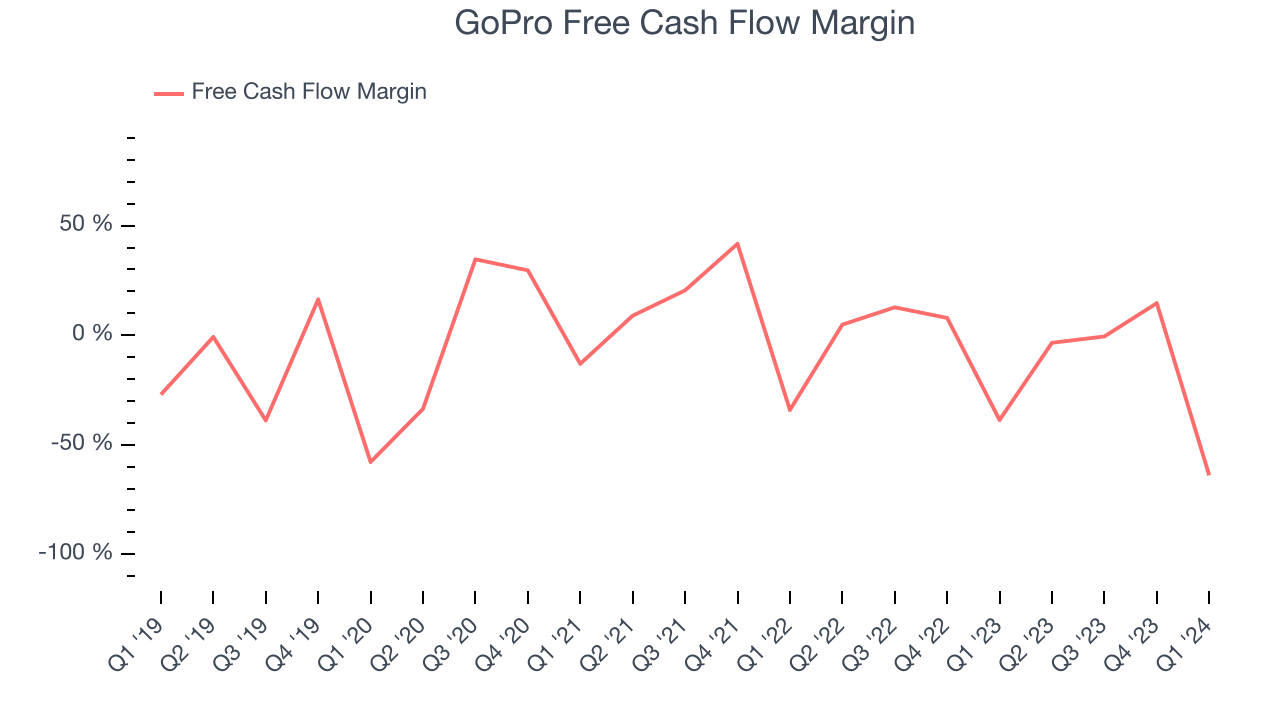
GoPro burned through $99.37 million of cash in Q1, equivalent to a negative 63.9% margin, reducing its cash burn by 47% year on year.
Return on Invested Capital (ROIC)
EPS and free cash flow tell us whether a company was profitable while growing revenue. But was it capital-efficient? A company’s ROIC explains this by showing how much operating profit a company makes compared to how much money the business raised (debt and equity).
GoPro's five-year average return on invested capital was negative 26.3%, meaning management lost money while trying to expand the business. Its returns were among the worst in the consumer discretionary sector.
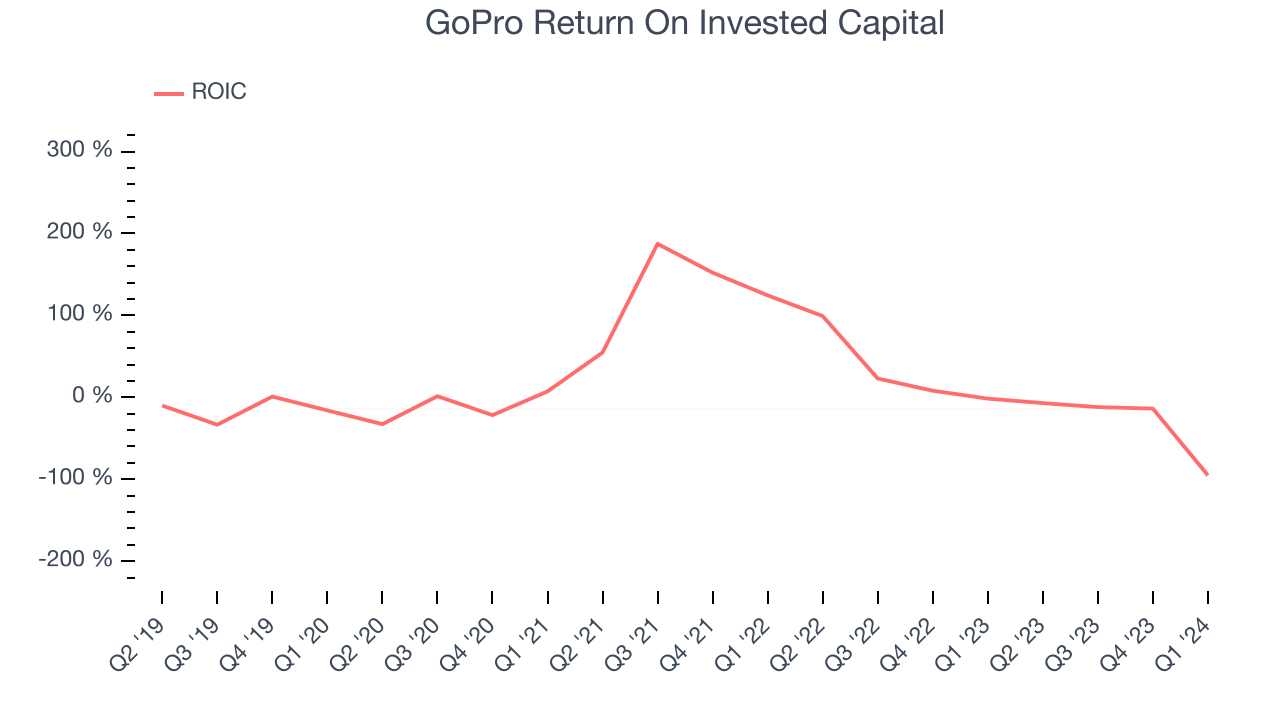
The trend in its ROIC, however, is often what surprises the market and drives the stock price. Unfortunately, GoPro's ROIC significantly decreased over the last few years. Paired with its already low returns, these declines suggest the company's profitable business opportunities are few and far between.
Balance Sheet Risk
Debt is a tool that can boost company returns but presents risks if used irresponsibly.
GoPro is a well-capitalized company with $133.7 million of cash and $126.2 million of debt, meaning it could pay back all its debt tomorrow and still have $7.42 million of cash on its balance sheet. This net cash position gives GoPro the freedom to raise more debt, return capital to shareholders, or invest in growth initiatives.
Key Takeaways from GoPro's Q1 Results
We were impressed by how significantly GoPro blew past analysts' revenue and adjusted EBITDA expectations this quarter. Zooming out, we think this was a good quarter that should have shareholders cheering. The stock is up 6.3% after reporting and currently trades at $1.95 per share.
Is Now The Time?
GoPro may have had a good quarter, but investors should also consider its valuation and business qualities when assessing the investment opportunity.
We cheer for all companies serving consumers, but in the case of GoPro, we'll be cheering from the sidelines. Its revenue has declined over the last five years, but at least growth is expected to increase in the short term. And while its projected EPS for the next year implies the company's fundamentals will improve, the downside is its number of cameras sold has been disappointing. On top of that, its relatively low ROIC suggests it has historically struggled to find compelling business opportunities.
While we've no doubt one can find things to like about GoPro, we think there are better opportunities elsewhere in the market. We don't see many reasons to get involved at the moment.
Wall Street analysts covering the company had a one-year price target of $2.20 per share right before these results (compared to the current share price of $1.95).
To get the best start with StockStory, check out our most recent stock picks, and then sign up for our earnings alerts by adding companies to your watchlist here. We typically have the quarterly earnings results analyzed within seconds of the data being released, and especially for companies reporting pre-market, this often gives investors the chance to react to the results before the market has fully absorbed the information.
